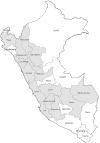Diagnosis of Carrion's disease by direct blood PCR in thin blood smear negative samples
- PMID: 24651298
- PMCID: PMC3961319
- DOI: 10.1371/journal.pone.0092283
Diagnosis of Carrion's disease by direct blood PCR in thin blood smear negative samples
Abstract
Bartonella bacilliformis is the etiologic agent of Carrion's disease. This disease has two well established phases, the most relevant being the so called Oroya Fever, in which B. bacilliformis infect the erythrocytes resulting in severe anemia and transient immunosuppression, with a high lethality in the absence of adequate antibiotic treatment. The presence of B. bacilliformis was studied in 113 blood samples suspected of Carrion's disease based on clinical criteria, despite the absence of a positive thin blood smear, by two different PCR techniques (using Bartonella-specific and universal 16S rRNA gene primers), and by bacterial culture. The specific 16S rRNA gene primers revealed the presence of 21 B. bacilliformis and 1 Bartonella elizabethae, while universal primers showed both the presence of 3 coinfections in which a concomitant pathogen was detected plus Bartonella, in addition to the presence of infections by other microorganisms such as Agrobacterium or Bacillus firmus. These data support the need to implement molecular tools to diagnose Carrion's disease.
Conflict of interest statement
Figures
References
-
- Breña Chávez JP, Maguiña Vargas CP, Hernández Diaz HR, Castillo Díaz ME, Pozo Tovar WE (2006) Bartonelosis aguda en niños: estudio de 32 casos en el Instituto Especializado de Salud del Niño y el Hospital Nacional Cayetano Heredia (Período 1993–2003). Rev Med Hered 17: 122–131.
-
- Eicher S, Dehio C (2012) Bartonella entry mechanisms into mammalian host cells. Cell Microbiol 14: 1166–1173. - PubMed
-
- Ihler GM (1996) Bartonella bacilliformis: dangerous pathogen slowly emerging from deep background. FEMS Microbiol Lett 144: 1–11. - PubMed
-
- Ticona E, Huaroto L, Garcia Y, Vargas L, Madariaga MG (2010) The pathophysiology of the acute phase of human bartonellosis resembles AIDS. Med Hypotheses 74: 45–49. - PubMed
-
- Maguiña C, Gotuzzo E (2000) Bartonellosis - new and old. Infect Dis Clin North Am 14: 1–22. - PubMed
Publication types
MeSH terms
LinkOut - more resources
Full Text Sources
Other Literature Sources


